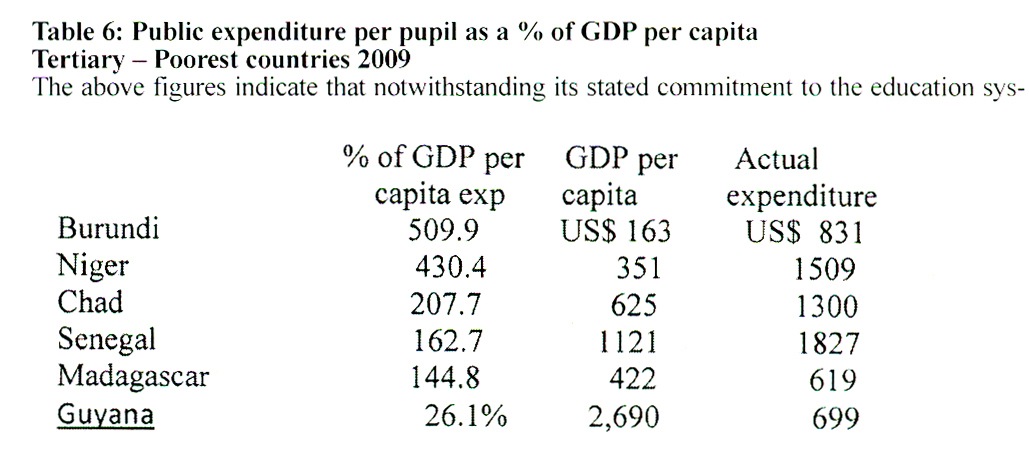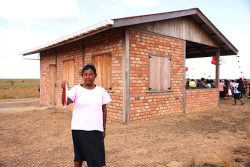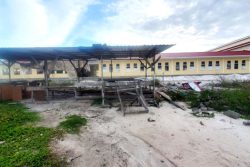Of the seven Caribbean countries surveyed in the recent United Nations Development Programme (UNDP) Citizens Security Survey, Guyana has experienced the greatest loss in human development caused by inequality between the respective achievements of men and women.
The survey, which was released last Wednesday in Trinidad, looked at the Gender Inequality Index (GII) which reflected women’s disadvantage in three dimensions—reproductive health, empowerment and economic activity—for as many countries as data of reasonable quality allow.
According to the report, the 2011 score on the GII has been estimated for Trinidad and Tobago (0.331), Barbados (0.364), Jamaica (0.450), and Guyana (0.551).
“The scores reflect a percentage loss in achievement across the three dimensions that arises because of gender inequality of 33.1, 36.4, 45.0 and 55.1 percent, respectively. Trinidad and Tobago, as well as Barbados, experienced the least loss, while Guyana experienced the greatest loss. In the case of Jamaica and Guyana, the loss is higher than the LAC (Latin American Caribbean) average (44.5 percent),” the report said.
The survey for the report was done in Antigua and Barbuda, Barbados, Guyana, Jamaica, Saint Lucia, Suriname, and Trinidad and Tobago. The Caribbean Human Development Report 2012 contains the findings of the survey.
Meanwhile, according to the report trends, while the countries show positive average growth rates in the Human Development Index (HDI) between 1980 and 2011, the increase in life expectancy ranged from 10.4 years in Guyana to 2.6 years in Jamaica.
“Barbados has the longest life expectancy, at 76.8 years, and Guyana has the shortest, at 69.9 years, followed by Suriname, at 70.6 years.”
In education, the mean years of schooling in 2011 varied from 7.2 years in Suriname to 9.3 and 9.6 years in Barbados and Jamaica, respectively. The increase in gross national income since 1980 shows positive trends in all seven countries.
According to the report, the HDI for Barbados for 2011 is 0.793, positioning the country in the very high human development category and a rank of 47 among 187 countries and territories. For the rest of the countries, with the exception of Suriname and Guyana, the HDI ranges between 0.764 and 0.723, positioning these in the high human development category. Suriname and Guyana, with HDIs of 0.680 and 0.633, respectively, are in the medium human development category. Among the seven countries only Barbados, Antigua and Barbuda, and Trinidad and Tobago have HDIs higher than the HDI for the LAC region with 0.731.
On the issue of crime the report found that rape is one of the most underreported crimes worldwide.
“The underreporting transcends age, race, class and geography. According to worldwide estimates, 60 per cent of all sexual crimes go unreported, and one in three women will be raped, beaten, forced into sex, or otherwise assaulted in her lifetime,” it said.
It was noted that in countries such as Guyana, Jamaica, and Trinidad and Tobago, the risk of sexual victimization increases in specific geographical areas and among specific subpopulations.
Further, the report said, across the Caribbean, rape rates are relatively high, and clearance rates on cases are low; so, by extension, conviction rates are also low.
For example, the report said, during the period 1970 to 2009, the average clearance rate for cases of rape and carnal abuse in Jamaica was 48 per cent. It declined from 62 per cent in 1970, was lowest, at 35 per cent, in 1995, and then rose to 50 per cent in 2009.
Domestic Violence
Domestic violence continues to be a major human rights violation in the countries and according to the report it takes many forms, including sexual, emotional, physical, psychological and economic abuse. It is often accompanied by child maltreatment and can be directed towards a person regardless of age, sex, sexual orientation, social class and marital or other status.
Guyana has been plagued by a growing domestic violence rate and, according to the report, across the region, approximately 11 per cent of the surveyed respondents of both sexes reported experience with domestic violence.
“The rates ranged from a low of 6 per cent of respondents in Jamaica to a high of 17 per cent in Guyana,” it stated.
Gender-based violence has been a persistent problem in the region. It is, however, now more well understood and can be controlled and prevented more effectively by interventions that interrupt the cycle of violence and the patterns of conflict that are associated with it.
Over 14 per cent of the respondents in the survey had been victims of domestic violence many times, a few times, or on one occasion. Of these, 8.6 per cent had been injured by partners; 10.8 per cent had been threatened by partners; and 21.4 per cent had been sworn at or insulted by partners.
By country, only in Jamaica and in Trinidad and Tobago did fewer than 10 per cent of the sample report themselves as victims (6.8 per cent and 9.8 per cent, respectively), while Saint Lucia had the highest proportion, at 51.2 per cent; Guyana, at 43.3 per cent; Suriname, at 19.1 per cent; Antigua and Barbuda, at 18.7 per cent; and Barbados at 15.7 per cent.
The highest shares of respondents who reported experiencing domestic violence many times—4.1 per cent—were in Suriname and in Antigua and Barbuda.
It was noted that since the introduction of the model legislation, domestic violence legislation has been enacted widely across the region, with some exceptions.
However, concerns have been raised about the replication of weaknesses in the model. Nonetheless, Trinidad and Tobago’s Domestic Violence Act that mandates police to respond and keep careful records of all reports, has emerged as a model that has influenced nations such as Dominica, Grenada and Suriname.
More violent
Meantime, the report found that the region has become more violent and this is the main challenge facing Caribbean countries.
“The rate, level of intensity, and primary form of violence, however, vary from country to country. In those countries with the highest rates of violence, organized crime and gang violence present the greatest challenge,” the report said.
In others, gender-based violence is the main concern. Regardless of the primary forms, all countries should be encouraged to improve the capacity of their institutions to respond effectively to these problems, the report suggested.
And the risk of violent offending and violent victimization among young people has increased. According to the report this has occurred in a context of high levels of youth unemployment, inadequate educational opportunities, and exposure to violence at home, in schools, in communities and in the wider society. At the same time, youth continue to express feelings of exclusion from national and regional governance processes, which helps predispose them to participate in alternative structures, including gangs.
The report however warned that while the problem of youth violence warrants urgent attention, exaggeration of the problem, particularly through anecdotes reported in the media, may serve to stereotype youth, particularly young males.
“Stereotyping contributes to the adoption of heavy-handed and rights-violating security responses that foster youth exclusion and unnecessary institutionalization through the criminal justice system,” the report said.
Nonetheless, it said, all instances of youth violence, however small in proportion to the incidence of violence generally, should be taken seriously.
It suggested that interventions aimed at reducing violence must acknowledge youth agency and the rights of youth to participate in the design, implementation and monitoring of violence prevention processes. Significant opportunities exist for youth participation in a context in which the majority of Caribbean youth surveyed have positive attitudes to participation in community activities and supporting law enforcement officers. These young people, it said, have expressed the willingness to contribute to violence reduction in their countries.
Justice system delays, low
conviction rates
On the issue of the criminal justice system, the report warned that evidence processing backlogs will become even more resonant as Caribbean nations grow increasingly reliant on forensic evidence to close cases.
It pointed out that the United States is currently dealing with massive backlogs in DNA evidence.
“While DNA is a wonderful tool for identifying and convicting offenders, processing DNA evidence is expensive and resource-intensive and is likely to worsen case processing delays and backlogs,” the report warned.
It noted that backlogs are, however, not merely a matter of efficiency as they go directly to the question of whether defendants are being treated justly.
“Consider Guyana, which reports that, in 2010, nearly 41 per cent of its prisoners had not yet been tried or convicted on the current charges for which they were being detained,” the survey said.
It said that for defendants who are not guilty, backlogs might mean spending a lot of time in jail for offences they did not commit.
In the case of Suriname it was noted that many prisoners awaiting appeal end up serving their full original sentence before their appeal is heard because there are not enough judges to adjudicate these cases. The general consensus within the region is that backlogs are exacerbated by inadequate staffing.
However, the survey said, even attempts to address these concerns highlight the crippling extent of the problem. Guyana again was used as an example where it reduced to some extent its backlog in the civil court under a special project whereby part-time judges were appointed to adjudicate cases and help eliminate the backlog. To eliminate the backlog in criminal cases, a similar strategy was proposed in the Guyana Justice Sector Reform Strategy of 2006–2010. However, even with this programme in place, the shortages of judges made it virtually impossible to reduce the civil litigation backlog.
“Estimates suggest that, even if two judges were assigned and even if each one concluded one civil matter every working day of the year (249 days), this would only lead to the completion of 498 cases out of an average of 5,600 cases filed, thus leaving a backlog of 5,102 cases.”
No silver-bullet solutions have emerged in the Caribbean for case processing delays and backlogs. As more of these nations begin using sophisticated forensic evidence processing techniques (such as ballistics imaging and DNA profiling), it is likely that the delays will actually worsen.
Meanwhile, the report said that although systematic data are not available, scattered evidence suggests that conviction rates in the Caribbean are alarmingly low. For instance, Guyana’s Justice Sector Reform Strategy 2006–2010 reports that an estimated “90% of criminal prosecutions in the Magistrates Courts are unsuccessful.”








